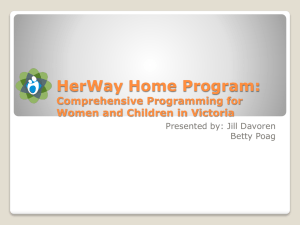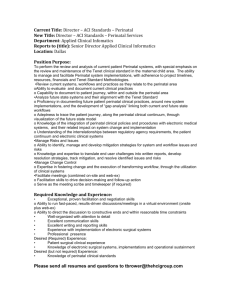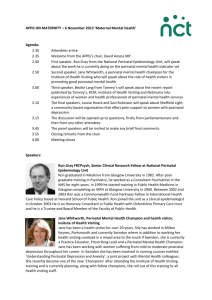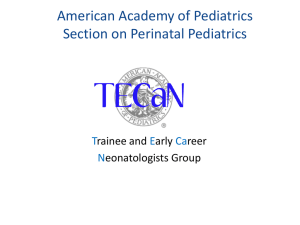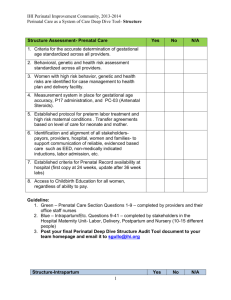HFA Labor, Delivery, and PNC Module
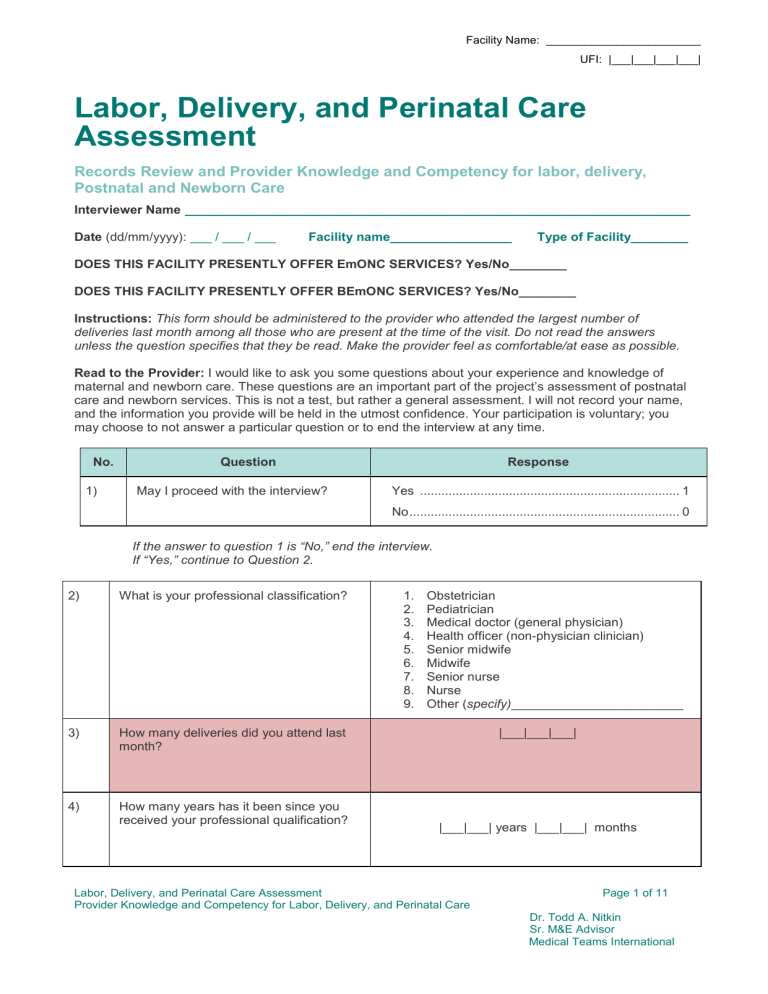
Facility Name: ________________________
UFI: |___|___|___|___|
Labor, Delivery, and Perinatal Care
Assessment
Records Review and Provider Knowledge and Competency for labor, delivery,
Postnatal and Newborn Care
Interviewer Name _______________________________________________________________________
Date (dd/mm/yyyy): ___ / ___ / ___ Facility name_________________ Type of Facility________
DOES THIS FACILITY PRESENTLY OFFER EmONC SERVICES? Yes/No________
DOES THIS FACILITY PRESENTLY OFFER BEmONC SERVICES? Yes/No________
Instructions: This form should be administered to the provider who attended the largest number of deliveries last month among all those who are present at the time of the visit. Do not read the answers unless the question specifies that they be read. Make the provider feel as comfortable/at ease as possible.
Read to the Provider: I would like to ask you some questions about your experience and knowledge of maternal and newborn care. These questions are an important part of the project’s assessment of postnatal care and newborn services. This is not a test, but rather a general assessment. I will not record your name, and the information you provide will be held in the utmost confidence. Your participation is voluntary; you may choose to not answer a particular question or to end the interview at any time.
No. Question Response
1) May I proceed with the interview? Yes ......................................................................... 1
No ............................................................................ 0
If the answer to question 1 is “No,” end the interview.
If “Yes,” continue to Question 2.
2) What is your professional classification?
3) How many deliveries did you attend last month?
1.
Obstetrician
2.
Pediatrician
3.
Medical doctor (general physician)
4.
Health officer (non-physician clinician)
5.
Senior midwife
6.
Midwife
7.
Senior nurse
8.
Nurse
9.
Other ( specify) ________________________
|___|___|___|
4) How many years has it been since you received your professional qualification?
|___|___| years |___|___| months
Labor, Delivery, and Perinatal Care Assessment Page 1 of 11
Provider Knowledge and Competency for Labor, Delivery, and Perinatal Care
Dr. Todd A. Nitkin
Sr. M&E Advisor
Medical Teams International
Facility Name: ________________________
UFI: |___|___|___|___|
Response
SKIP
PATTERN
No. Question
5) Does this facility provide a waiting shelter for expectant mothers who have travelled to the facility to deliver?
6) If yes, who cares for the women while they are in the shelter?
1.
2.
Yes
No
7) What are the primary aspects of focused antenatal care?
(Circle all spontaneous answers and ask:
Anything else?
)
8) Which women require a special care plan?
(Circle all spontaneous answers and ask:
Anything else?
)
1.
Health Worker
2.
Other staff
3.
Unqualified person
4.
No one
5.
Other (List)_________________________
1.
Minimum of 4 consultations
2.
Ensure woman has birth plan
3.
Prevent illness and promote health (tetanus toxoid vaccine, iron tablets, protection against malaria)
4.
Detect existing illnesses and manage complications
5.
Teach the danger signs (of pregnancy, childbirth, and the postpartum period)
6.
Promote breastfeeding
1.
Women who have had a cesarean
2.
Women with 5 or more deliveries
3.
Interval <2 years or >5 years between pregnancies
4.
Previous stillbirth
5.
Previous neonatal death
6.
Previous instrumental delivery (vacuum extraction, forceps)
7.
History of severe obstetric complications
8.
Previous obstetric fistula repair
Labor, Delivery, and Perinatal Care Assessment Page 2 of 11
Provider Knowledge and Competency for Labor, Delivery, and Perinatal Care
Dr. Todd A. Nitkin
Sr. M&E Advisor
Medical Teams International
No.
9) How do you know when a pregnant woman is in labor?
(Circle all spontaneous answers and ask:
Anything else?
)
10)
Question
For a woman in labor, what observations do you make as you monitor her progress?
(Circle all spontaneous answers and ask:
Anything else?
)
1.
2.
3.
Facility Name: ________________________
UFI: |___|___|___|___|
Response
SKIP
PATTERN
Regular uterine contractions
Dilation of the cervix
Discharge of blood and mucus
4.
Breaking of the waters/ ruptured membranes
1.
Fetal heartbeat
2.
Color of amniotic fluid
3.
Degree of molding
4.
Dilatation of the cervix
5.
Descent of the head
6.
Uterine contractions
7.
Maternal blood pressure
8.
Maternal temperature
9.
Maternal pulse
11) Where do you register these observations?
(Circle all spontaneous answers and ask:
Anything else?
)
1.
On a partograph
2.
In the patient’s clinical record
3.
4.
On the partograph in the prenatal card
On a piece of paper
12) What are the actions taken during active management of the third stage of labor?
(Circle all spontaneous answers and ask:
Anything else?
)
1.
Immediate oxytocin
(within 1 –2 minutes)
2.
Immediate Ergometrine
(within 1 –2 minutes)
3.
Immediate Misoprostol
(within 1 –2 minutes)
4.
Delayed Cord Clamping for 2 – 3 minutes
5.
Controlled cord traction
6.
Uterine massage
13)
For how long should the mother stay in the facility following normal delivery?
________ HOURS
_________DAYS
_________WEEKS
Labor, Delivery, and Perinatal Care Assessment Page 3 of 11
Provider Knowledge and Competency for Labor, Delivery, and Perinatal Care
Dr. Todd A. Nitkin
Sr. M&E Advisor
Medical Teams International
No.
14)
Question
Within what time frame should the mother be seen for first post-natal health check after normal delivery?
15) The last time you delivered a baby, what immediate care did you give the newborn?
(Circle all spontaneous answers and ask:
Anything else?
)
16) When a woman arrives at the facility with heavy bleeding or develops severe bleeding after giving birth, what signs do you look for?
((Circle all spontaneous answers and ask:
Anything else?
)
1.
Same day
2.
Within 2 days
3.
Within 1 week
4.
Over 1 week
5.
Don’t know
Facility Name: ________________________
UFI: |___|___|___|___|
Response
SKIP
PATTERN
1.
Clean the baby’s mouth, face, and nose of secretions
2.
Ensure the baby is breathing
3.
Ensure the baby is dry
4.
Observe for color
5.
Ensure baby is kept warm
(skin-to-skin)
6.
Administer prophylaxis for the eyes
7.
Weigh the baby
8.
Care for the umbilical cord
9.
Initiate breastfeeding within the first 30 minutes
10.
Evaluate/examine the newborn within the first
Hour
11.
Measure the baby’s temperature
12.
IV intramuscular vitamin K injection 90 minutes after birth
1.
Signs of shock (dizziness, low blood pressure)
2.
Amount of external blood
3.
Signs of anemia
4.
Damage to the genital tract
5.
Whether the uterus is contracted
6.
Retained products or retained placenta
7.
Full bladder
Labor, Delivery, and Perinatal Care Assessment Page 4 of 11
Provider Knowledge and Competency for Labor, Delivery, and Perinatal Care
Dr. Todd A. Nitkin
Sr. M&E Advisor
Medical Teams International
No.
17)
Question
When a woman develops heavy bleeding after delivery, what do you do?
(Circle all spontaneous answers and ask:
Anything else?
)
Facility Name: ________________________
UFI: |___|___|___|___|
Response
SKIP
PATTERN
1.
Massage the fundus
2.
Give ergometrine or oxytocin
(IV or IM)
3.
Begin IV fluids
4.
Empty full bladder
5.
Take blood for hemoglobin and crossmatching
6.
Examine woman for lacerations
7.
Manually remove retained products
8.
Refer
1.
Yes
2.
No
NO SKIP
Q.20
18)
19)
20)
Do you have the capability to perform blood transfusions in this facility?
If blood transfusion are possible, describe the primary supply of blood.
(Circle one)
When a woman who just gave birth has a retained placenta, do? what do you
(Circle all spontaneous answers and ask:
Anything else?
)
1.
Blood comes from central blood bank
2.
Blood comes from a facility blood bank
3.
Blood is collected from family or friends as needed
(i.e., direct transfusion)
4.
Other (specify) ________________________
1.
Empty the bladder
2.
Check for signs of separation of placenta before controlled cord traction
3.
Give or repeat oxytocin
4.
Do manual removal of the placenta
5.
Administer IV fluids
6.
Monitor vital signs for shock and act
7.
Check that uterus is well contracted
8.
Determine blood type and cross-match
9.
Prepare operating theater
10.
Refer
Labor, Delivery, and Perinatal Care Assessment Page 5 of 11
Provider Knowledge and Competency for Labor, Delivery, and Perinatal Care
Dr. Todd A. Nitkin
Sr. M&E Advisor
Medical Teams International
No.
21)
Question
What provisions do you provide to prevent hypothermia of the newborn?
(Circle all spontaneous answers and ask:
Anything else?
)
Facility Name: ________________________
UFI: |___|___|___|___|
Response
1.
Immediate drying
2.
Immediate warming
3.
Immediate placement skin to skin with mother
4.
Delayed bathing beyond 6 hours
5.
Cover the baby’s head
6.
Wrap the baby in cloth or blanket
SKIP
PATTERN
22)
When a newborn is LBW what extra care would you give?
23)
Should anything be placed on the umbilical cord either before or after it was cut?
24)
If yes, what should be placed on the cut cord?
1.
Immediate drying
2.
Immediate warming
3.
Maintain prolonged skin to skin contact with mother
4.
Delayed bathing
5.
Assist to breastfeed or if unable feed via tube or cup
6.
Refer if danger signs present or if under 2.0 kg
1.
YES
2.
NO
3.
DON’T KNOW
1.
2.
3.
CHLORHEXIDINE
OTHER ANTISPETIC
OIL
4.
OTHER ____________________ i.
(SPECIFY)
Labor, Delivery, and Perinatal Care Assessment Page 6 of 11
Provider Knowledge and Competency for Labor, Delivery, and Perinatal Care
Dr. Todd A. Nitkin
Sr. M&E Advisor
Medical Teams International
No.
26)
Question
25) What are the signs and symptoms of infection, or sepsis, in the newborn?
(Circle all spontaneous answers and ask:
Anything else?
)
When the newborn presents signs of infection, what initial steps do you take?
(Circle all spontaneous answers and ask:
Anything else?
)
27)
28)
If a baby is not breathing at birth what initial steps in basic newborn resuscitation?
(Circle all spontaneous answers and ask:
Anything else?
)
If these initial steps in basic newborn resuscitation do not work, what further steps should be undertaken?
(Circle all spontaneous answers and ask:
Anything else?
)
Facility Name: ________________________
UFI: |___|___|___|___|
Response
SKIP
PATTERN
1.
Less movement (poor muscle tone)
2.
Poor or no breastfeeding
3.
Hypothermia or hyperthermia
4.
Restlessness or irritability
5.
Difficulty breathing or fast breathing or chest indrawing
6.
Deep jaundice
7.
Severe abdominal distention
1.
Explain the situation/condition to the mother or caregiver
2.
Continue to breastfeed or give breast milk that has been expressed with nasogastric tube if necessary
3.
Keep airways open
4.
Begin antibiotics
5.
Refer
1.
Rub back two or three times in addition to drying infant for stimulation
2.
Check airway, breathing, and circulation
3.
Place with mother skin to skin and monitor
1.
Neonatal resuscitation with mask
2.
Utilize surfactant for Respiratory Distress
Syndrome
3.
Other (List)_______________________
Labor, Delivery, and Perinatal Care Assessment Page 7 of 11
Provider Knowledge and Competency for Labor, Delivery, and Perinatal Care
Dr. Todd A. Nitkin
Sr. M&E Advisor
Medical Teams International
No.
29)
Question
How do you recognize severe jaundice?
(Circle all spontaneous answers and ask:
Anything else?
)
30)
How is jaundice treated at this facility?
(Circle all spontaneous answers and ask:
Anything else?
)
31)
32)
33)
What are the components of the assessment of a mother in the first 24 hours after childbirth?
(Circle all spontaneous answers and ask:
Anything else?
)
When should women be treated with antihypertensive drugs following childbirth?
(Circle all spontaneous answers and ask:
Anything else?
)
What does this facility tell mothers after delivery about breastfeeding?
(Circle all spontaneous answers and ask:
Anything else?
)
Facility Name: ________________________
UFI: |___|___|___|___|
Response
1.
The face is yellow on the first day
2.
The palms or soles are yellow at any time
3.
Other
(List)____________________________
SKIP
PATTERN
1.
Phototherapy
2.
Intravenous immune globulin
3.
Other (List)
_______________________________
1.
Check her blood pressure immediately after delivery and a second time within 6 hours.
2.
Evaluate for vaginal bleeding, uterine contraction, temperature, and heart rate.
3.
Document ability to void urine within 6 hours
1.
If they have severe postpartum hypertension with a systolic blood pressure (SBP) > 140
2.
If they were treated with antihypertension drugs during pregnancy
1.
2.
3.
Mothers should immediately initiate breastfeeding, within 30 minutes of birth
Mothers should exclusively beast feed their newborn for the first 6m of life
Mothers should give the newborn colostrum
4.
Nothing
5.
Do not know
Labor, Delivery, and Perinatal Care Assessment Page 8 of 11
Provider Knowledge and Competency for Labor, Delivery, and Perinatal Care
Dr. Todd A. Nitkin
Sr. M&E Advisor
Medical Teams International
No.
34)
Question
What does this facility tell mothers who have HIV after delivery about breastfeeding?
Facility Name: ________________________
UFI: |___|___|___|___|
Response
SKIP
PATTERN
1.
Mothers should immediately initiate breastfeeding, within 30 minutes of birth
2.
Mothers should exclusively beast feed their newborn
3.
Mothers should give the newborn colostrum
4.
Mothers should not breastfeed their child due to the risk of transmitting HIV
5.
Nothing
6.
Do not know
35)
Before discharge from the health facility, what counselling do you provide the mother?
1.
Teach the signs and symptoms of postpartum hemorrhage
2.
Teach the signs and symptoms of pre- eclampsia / eclampsia
3.
Teach the signs and symptoms of infection
4.
Teach the signs and symptoms of thromboembolism
5.
Give nutrition advice and iron /folic acid supplementation for 3 months postpartum
6.
Advice on hygiene and hand washing
7.
Advice on birth spacing and contraception
8.
Advice on the use of insecticide treated bed nets.
9.
Teach the signs of any postpartum depression
10.
Advise mother to return for PNC at clinic in 6 days
36)
What postnatal care does a new baby and mother need after discharge from the facility?
1.
Home visit mother and baby at least 2 more times in the first week.
2.
Check newborn is breastfeeding well
3.
Ensure no danger signs
4.
Check cord and reinforce clean and dry cord care or chlorhexidine daily
5.
Advise mother to return to the clinic for postnatal check and for routine immunization at 6 days
Labor, Delivery, and Perinatal Care Assessment Page 9 of 11
Provider Knowledge and Competency for Labor, Delivery, and Perinatal Care
Dr. Todd A. Nitkin
Sr. M&E Advisor
Medical Teams International
No.
37)
Question
When was the last time that this health facility referred a patient to another facility due to emergency?
38)
To which facilities did you refer patients in the last month?
1.
In the last month
2.
1-3 months ago
3.
4-12 months ago
4.
Over a year ago
5.
Never
99. Do Not Know
Facility Name: ________________________
UFI: |___|___|___|___|
Response
SKIP
PATTERN
If 3, 4, 5 or
99, Skip Q. 39
1.
Hospital
2.
BEmONC center
3.
other PHU
88. Don’t Know
REGISTER/RECORD REVIEW
39)
Is the mother’s BP information listed in ANY
(at least 1) of the records reviewed?
1.
Yes
2.
No
40)
41)
How many of the 6 records reviewed had the mother’s
BP listed at least these 2 times:
1.
The first time immediately after birth
2.
A second time in
6 hours
Is the mother’s length of stay information listed in
ANY (at least 1) of the records reviewed?
Number of Records with BP taken immediately after birth AND again in 6 hours _________
1.
2.
Yes
No
42)
How many of the 6 records reviewed showed that the mother stayed in the unit for at least 24 hours?
Number of Records where mother stayed at least 24h _________
NO
NO
SKIP
Q.41
SKIP
Q.43
Labor, Delivery, and Perinatal Care Assessment Page 10 of 11
Provider Knowledge and Competency for Labor, Delivery, and Perinatal Care
Dr. Todd A. Nitkin
Sr. M&E Advisor
Medical Teams International
No.
43)
Question
Is the mother’s postnatal check information listed in
ANY (at least 1) of the records reviewed?
44)
45)
46)
How many of the 6 records reviewed revealed that the mother’s postnatal check occurred within 48 hours?
In the case of maternal death, is there a death audit and death review process?
What is the maternal death review process?
OBSERVE ITEMS IF
POSSIBLE
47)
48)
49)
50)
In the case of perinatal death, is there a death audit and death review process?
What is the perinatal death review process?
OBSERVE ITEMS IF
POSSIBLE
Ask to see where the register reflects maternal deaths: Is there a clear cause of death or review process noted?
Ask to see where the register reflects perinatal deaths: Is there a clear cause of death or review process noted?
Facility Name: ________________________
UFI: |___|___|___|___|
Response
SKIP
PATTERN
NO SKIP
Q.45
1.
Yes
2.
No
Number of records documenting a postnatal visit within 48h _________
1.
Yes
2.
No
1.
Report/Notify DCMO
2.
Verbal autopsy report reviewed
3.
Summary report sent to DCMO for review
4.
Review by committee completed at the district level
1.
Yes
2.
No
NO SKIP
Q.47
NO SKIP
Q.49
1.
Clinical Document review
2.
Verbal autopsy report reviewed
3.
Summary report and notify DCMO
4.
Review by district committee completed
1.
Yes
2.
No
1.
Yes
2.
No
Labor, Delivery, and Perinatal Care Assessment Page 11 of 11
Provider Knowledge and Competency for Labor, Delivery, and Perinatal Care
Dr. Todd A. Nitkin
Sr. M&E Advisor
Medical Teams International
